Video has revolutionized the delivery of information and training content.
Whether you are teaching people through online content or training internal coworkers, using video to share knowledge is becoming an expectation.
Don’t make folks spend their time pouring through long, wordy training manuals or documentation to learn about your product or service. In fact, 83% of people prefer watching videos to accessing instructional or informational content via text or audio.
The type of content you create matters just as much as the information you are trying to share, this includes video.
The problem is many companies struggle with how to create and deliver engaging and effective instructional videos that viewers will actually watch.
TechSmith conducted research to learn more about people’s viewing habits and preferences around instructional and informational videos.
Record professional videos with Camtasia
Camtasia’s features make video recording and editing super easy
Download NowHere’s what you’ll learn
- How to create videos that are effective and that get watched
- Why video keeps rising
- How to find and know your audience
- How long should you make your videos
- How to optimize video for search (SEO)
- Why people stop watching videos (and how you can avoid it)
- What is the best way to create videos for an international audience?
- Lessons from real-world videos
- How to start making your own videos
- Research methodology
We wanted to know how to create instructional videos that get watched.
In this guide, you will find actionable tips on how you can leverage these video statistics. In the end, you’ll be able to create effective video content that helps people learn new skills or gain new knowledge.
Highlights
- 83% of respondents prefer watching video to accessing information or instructional content via text or audio.
- Most respondents view videos two to four times per week.
- Despite changes in how and where people work, much of the 2021 data were consistent with our 2018 data.
- First impressions are important! Clear titles, good descriptions, and compelling thumbnails matter.
- YouTube is the most popular place to watch instructional and informational videos.
- Respondents prefer videos between five and 19 minutes long.
And here are the complete and final statistics, habits, and trends we found around video and how you can leverage them in 2022 and beyond.
Enjoy!
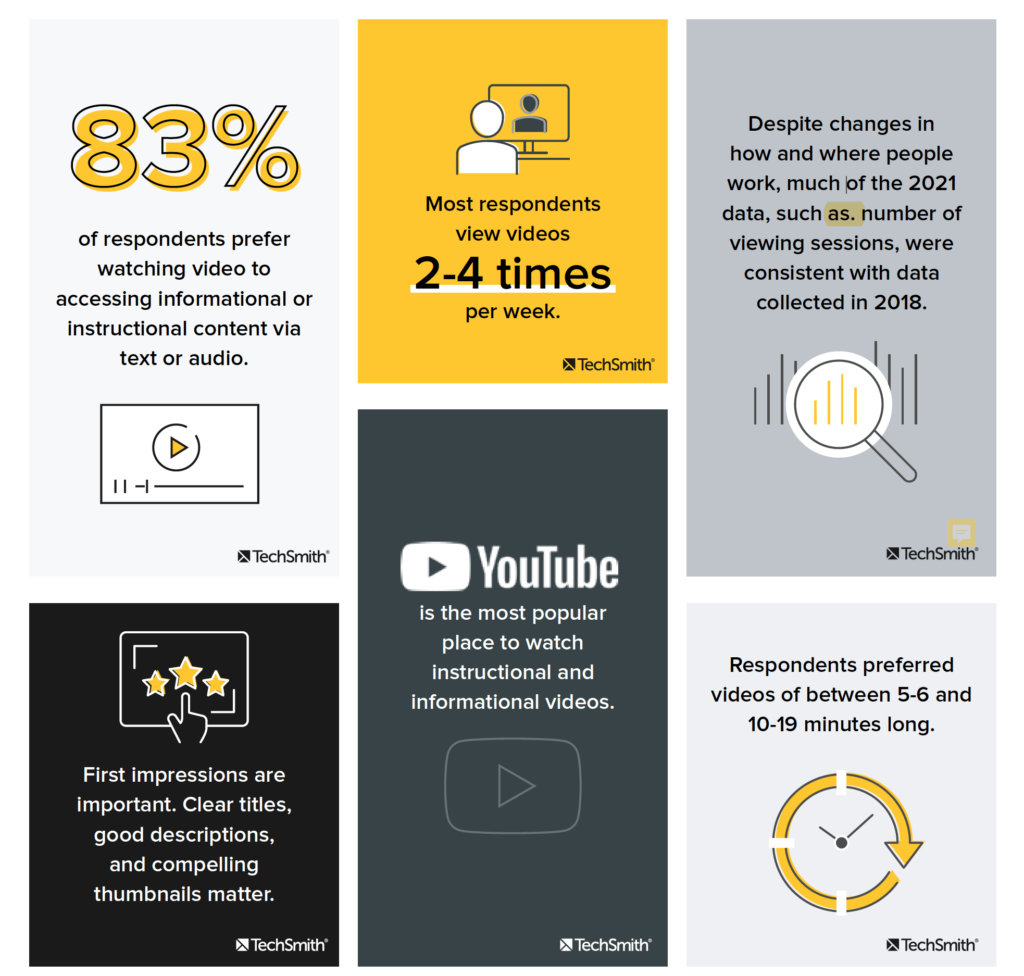
How to create videos that are effective and that get watched
Video has emerged as one of the most powerful and widely used formats for delivering training and instructions, regardless of who your audience is.
The vast majority of businesses have embraced video as a marketing, training, and communication tool. And while marketers say video is becoming ever more popular, marketing professionals aren’t the only ones who can benefit.
The acceptance and consumption of video (including mobile video) continue to grow across most departments, segments, and demographics.
This should come as no surprise.
As employees, students, and customers increasingly expect information to be available in video format, businesses are embracing video for its benefits, visual appeal, and effectiveness. In fact, 83% of people prefer watching videos to accessing instructional or informational content via text or audio.
The big question is no longer “Should I create a video?”
Instead, we need to be asking “How do I create videos that are effective and that get watched?”
We conducted research to discover user preferences and consumption habits across six different markets – Australia, Canada, France, UK, the US, and Germany.
The TechSmith Video Viewer research provides unique insights into when, why, and how people engage with informational and instructional video content. We’ll also walk you through the best practices to ensure your instructional and informational videos are efficient and effective.
Discover how you can revamp your own instructional and informational videos to find a better way to connect with your audience and build brand awareness.
Why video keeps rising
Video viewing figures are going up across the board. The Cisco Video Networking Index forecasts that video traffic will grow fourfold from 2017 to 2022.
And video will make up 82% of Internet traffic by the end of that period, up from 75% in 2017.
This growth can partially be attributed to the ever-increasing video file size, quality, and the rise of video streaming services. It also reflects the viewing practices and overall demand for video content.
The TechSmith Video Viewer Research shows that this trend also holds true for instructional and informational videos.
This year, 52% of people reported watching more than two instructional or informational videos each week. This is up from 51% in 2018 and up from 28% in 2013.
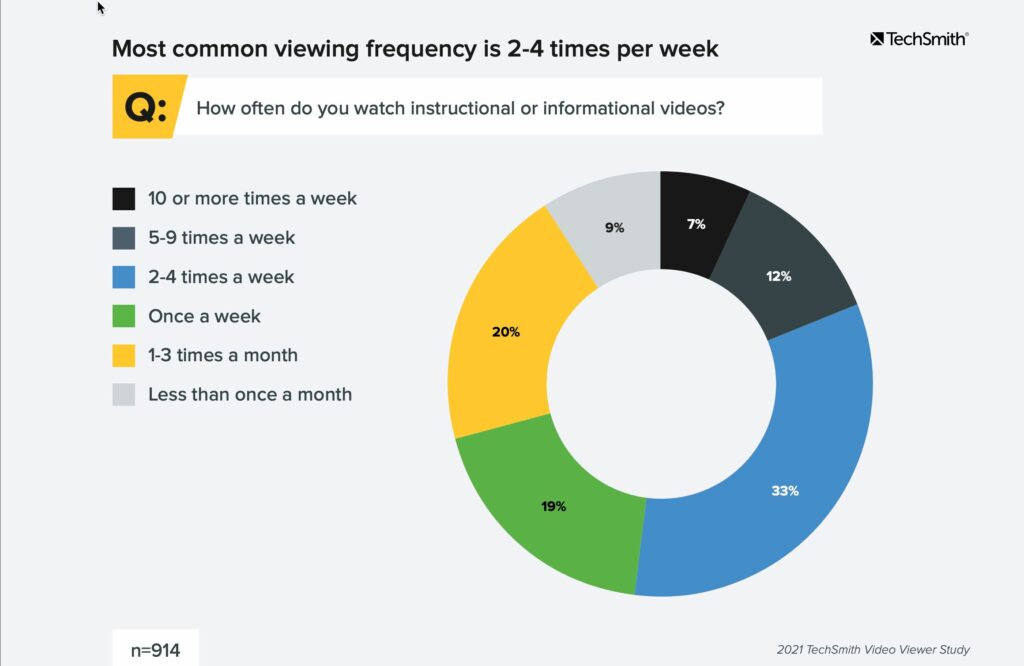
How to find and know your audience
When you create videos, it is important to define and understand the audience and their needs. Most people (25%) watch these videos to learn new skills for their job, followed closely at 22% by people who are genuinely interested in the topic.
Before you create a video, determine who you’re targeting by asking yourself questions like:
- Who are they?
- What problem are they trying to solve?
- What goals are they pursuing?
- Do they have previous experience with the topic?
- What will they need to accomplish their goals?
- Where and how will they likely find or access the video?
- What is their skill level?
- What related topics should they also be learning?
Carefully consider these factors when you plan and create your video content to ensure it will be helpful for your audience.
Consider cultural differences, as well. If your audience is international, keep in mind that some types of humor or cultural references may not work across multiple regions. Even simple hand gestures may be innocent in one culture and offensive in another.
How to grab their attention (and make them stay)
We know that video viewing is on the rise, and while younger audiences watch videos more frequently, it’s a medium that’s reaching people of all ages.
But the amount of available videos also means that viewers are more discerning toward what they watch.
Video creators need to think carefully about the style, structure, and format of their videos in order to meet viewers’ needs and expectations.
How long should you make your videos?
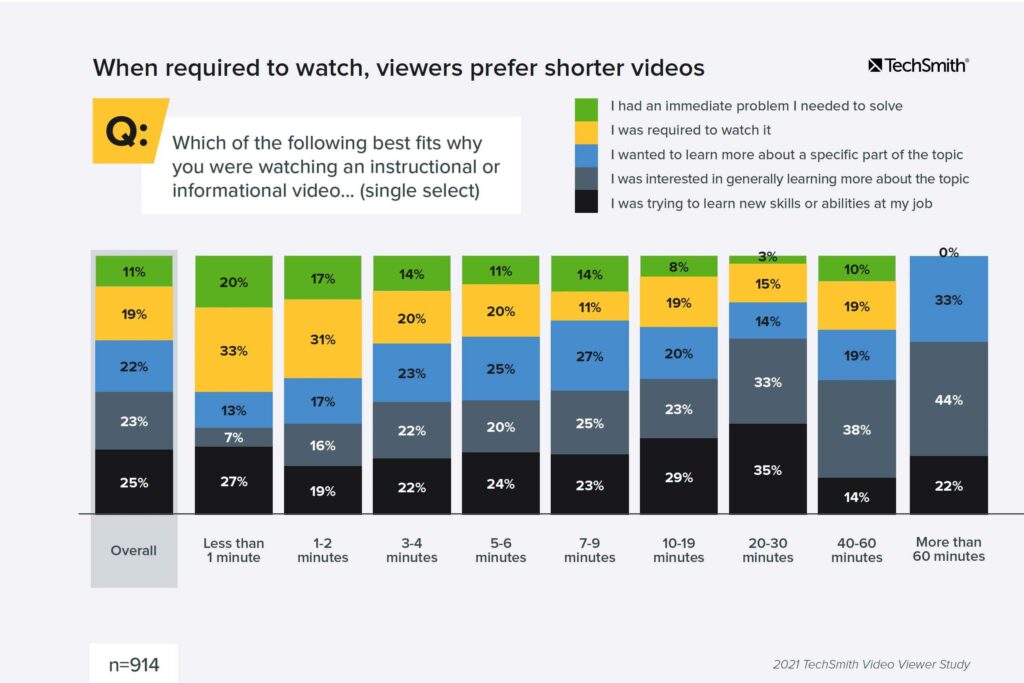
When it comes to video length preferences, it seems that there’s a “Goldilocks length”— not too short, and not too long.
Across all countries in our most recent study, the majority of viewers prefer instructional and informational videos in the ranges of 3-4 and 5-6 minutes.
Content over 20 minutes in length was only preferred by less than 10% of all participants.
So, just like Goldilocks’ porridge, you need to make sure that your video length is just right for its purpose. While some videos can be longer, make sure that you’re not overloading your viewer with information. Your video shouldn’t include information isn’t relevant or cover too much information.
In other words, make your video content as short as possible, yet as long as necessary.
These tips will help you to keep your video short and sweet, while including all of the points you want to make:
- Write a script or storyboard to plan your content and keep your video focused and short.
- Focus your video on a single topic with a single objective.
- Consider organizing your topic into a video-series or creating “microlearning” units, which deliver short units of information.
- For longer videos, create a table of contents to enable viewers to easily navigate the video and quickly access relevant sections.
Why people stop watching videos (and how you can avoid it)
Viewers don’t watch every video until the very end. That is a known and common behavior across all audiences. That said, you can gain a lot of value by exploring why.
Why did viewers stop watching their last video?
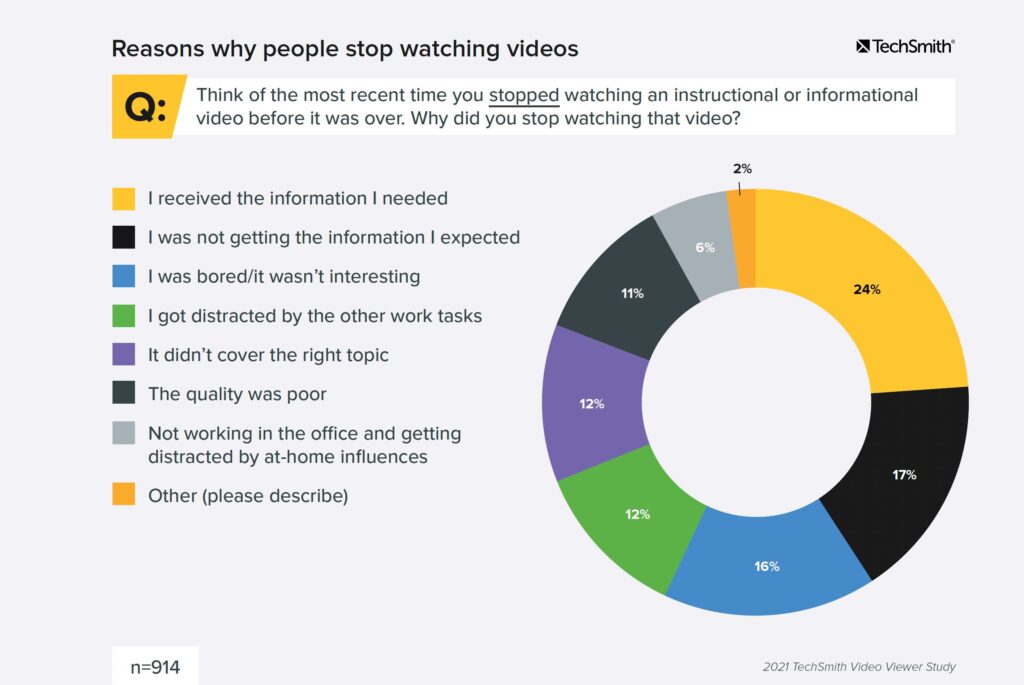
The most common reason for a viewer to stop an instructional or informational video before the end is that they got the information they needed and moved on. The second most common reason is that they didn’t get what they were looking for.
Armed with this knowledge, you can optimize their content to meet viewers’ expectations and reduce video drop-offs.
Your videos needs to match your viewers’ needs and expectations
You can help to set expectations for your viewers by controlling the initial experience with the content. This is primarily done by using a clear title and accurate description that conveys the video topic as well as the style of the video.
The actual video needs to match the description and product, it needs to be detailed enough, and should be easy to follow along (especially important for instructional videos).
The thumbnail, if applicable, can also relay upfront information for the viewers.
And if the video is embedded on a website or part of a course, you also need to provide enough context around the video (i. e. website text, course title) to let the viewer know what they should expect.
How to make your video interesting to keep viewers engaged?
Some topics and information may simply be dry and uninspiring, but an engaging presentation can keep viewers from getting bored and tuning out.
Follow these tips to make your content engaging to keep your viewers watching until the end:
- Use storytelling techniques, incorporating characters and a storyline that provoke emotion.
- Use an engaging speaker or voiceover to present the topic with passion and excitement.
- A visible speaker can also serve as an authentic ‘expert voice’ in your video, and you can leverage the existing experts within your company. Their knowledge of the subject will allow them to present information accurately and authentically.
- Include practical, real-life examples that your viewers can easily apply to their own lives.
- Make extensive use of good visuals, like images and icons to illustrate your concepts.
- Be particular about when you repeat information, or when you slow down: Both can be effective techniques, but can cause people to stop watching if overused.
- Humor can be a great asset to keep viewers engaged when executed well, assuming it’s appropriate to use with your topic and for your audience.
- Use familiar, everyday language in your script. Avoid overly formal expressions or jargon. Carefully consider your technical terms—while sometimes a bit dry, they may be critical to understanding and following the content.
- Prompt viewers to actively follow along with your video, post thought-provoking questions and ask for comments, feedback, and other engagement.
When you create video, be sure to create content that’s relevant, engaging, and useful. Regardless of where, when, or how people view your videos, focus on making your learning content as accessible as possible so that it can be viewed anywhere, at any time.
Your video doesn’t need to be high-quality
It may be surprising to learn that the video quality was not a common reason for viewers to stop watching a video. In fact, only 11% of viewers listed poor video quality as the main reason they stopped watching.
This provides another useful lesson for you:
Good content trumps perfect production.
This also reinforces the idea that easy-to-follow (50%) and relatable content (44%) are the overwhelming factors for getting users interested in your video. Visual effects or video quality doesn’t have the same effect.
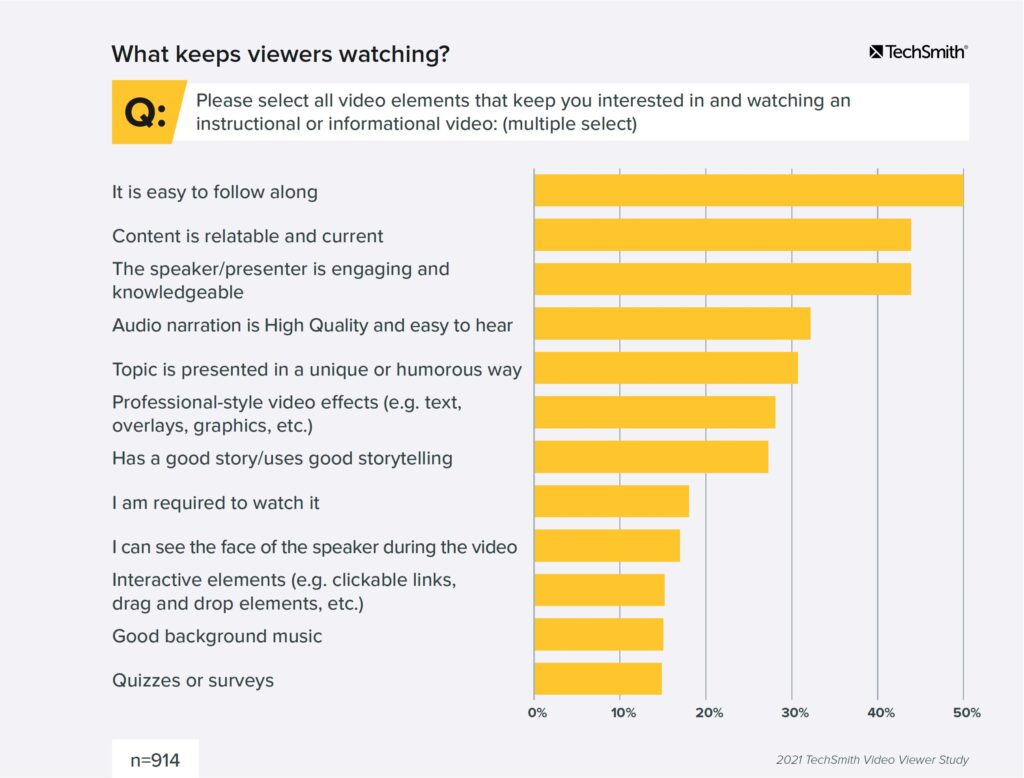
High-end equipment and super-fancy video effects aren’t necessarily a recipe for success.
Concentrate on writing accurate supporting copy and creating an interesting video rather than trying to create a Hollywood-quality blockbuster. Create content that keeps users interested and engaged, even if it’s a simple screen recording or video from an iPhone.
How to start making your own videos
It’s no secret that people increasingly look to video when they want to learn a new skill or information. Whether you need to share knowledge with one person or 100,000, a video offers a unique way to engage and enlighten viewers beyond the capabilities of written content.
This guide offers insights into how real people’s video preferences and habits, as well as analysis of great videos. This shines a light on how YOU can create better, more successful instructional and informational video content for your audience.
But ultimately, don’t be overwhelmed by the details.
Get out there and start creating videos!
Learn as you go and find out what works best for you.
It’s time for you to make some videos! We’d love for you to consider getting a free trial of TechSmith Camtasia by visiting the TechSmith website.
Camtasia – screen recorder and video editor
TechSmith Camtasia makes it easy to create informational videos for teaching, training, and explaining concepts.
Record your screen and add content you already have by importing slide decks, webinar recordings, video clips, images, and audio files. With Camtasia, you can…
- Add transitions, annotations, callouts, and effects with drag-and-drop ease to focus viewers’ attention and highlight key information.
- Add pre-built motion graphics, music tracks, and other assets to capture your viewers’ attention and that professional polish.
- Create quizzes, interactivity, and captions to improve viewer engagement.
- Produce MP4 files or upload your video to YouTube, Vimeo, Screencast, or LMS for easy sharing.
Research methodology
Video viewer survey
To understand more about how video is most effective, TechSmith conducted research to discover user preferences and video viewing habits.
The main portion of the research consists of a survey that was administered to 914 unique respondents in late June 2021. The recruitment, as well as the delivery of the survey, were conducted by Qualtrics, an independent research partner.
Similar versions of this survey were previously conducted in 2013, 2016, and 2018. This report focuses on the most recent results, but data from previous reports will be referenced for comparative purposes.
For the 2016 study, we surveyed 1,006 participants while the 2013 study involved surveying 1900 respondents, and the 2018 study surveyed 924. All studies used the same type of survey methodology, though the questions varied slightly year to year.
About the survey participants
Participants had to answer between 16 and 20 multiple-choice questions, and 3-6 open-ended questions about their attitudes towards technical videos, focusing on two different types of videos:
Instructional videos
A video that teaches a process, such as a step-by-step tutorial or how-to video.
For example: “How to add a new customer to the database.”
Informational videos
A video that delivers facts, ideas, or important information.
For example: “Overview of the new safety regulations” or “Insights from the last departmental meeting”.
Thank you!
Thank you so much for taking the time to read through the research. We can’t wait to see what you create this year!
If you have questions or comments you can always reach out to us on Facebook, Twitter, and LinkedIn.
Record professional videos with Camtasia
Camtasia’s features make video recording and editing super easy
Download Free Trial


Share